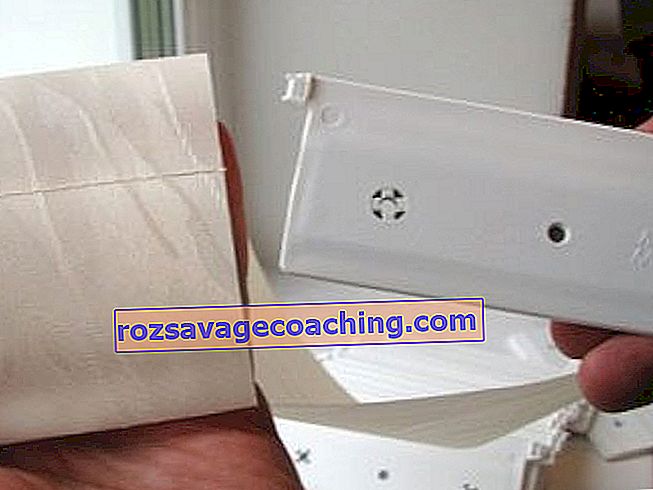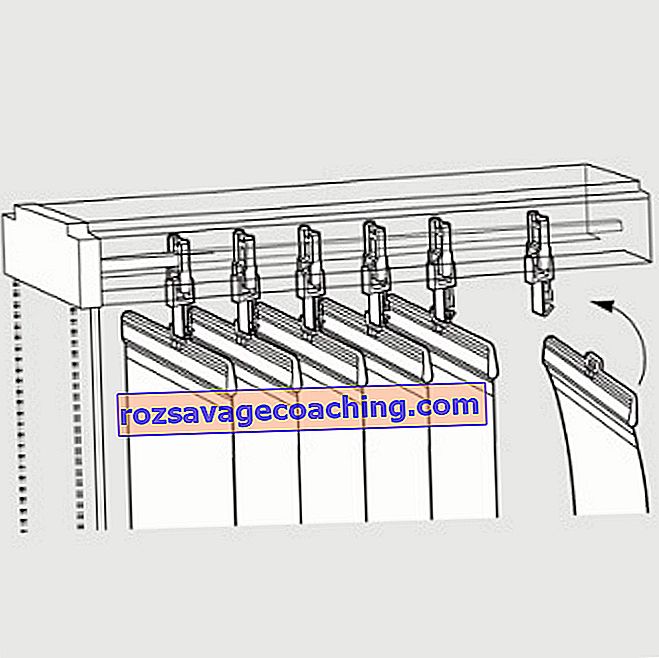
Blinds are an incredibly practical and compact type of window shade. In addition, in some cases they will be much more profitable financially than classic fabric canvases, the cost of which may be slightly overestimated. But sometimes it becomes necessary to remove them too, for cleaning, washing or simply changing the interior composition, so you need to familiarize yourself with some instructions for their use in order to remove this decorative object without damaging it.

Methods for removing blinds from a plastic window for washing
Of course, the blinds cannot always hang in the form in which they were installed. There are many cases that can be a good reason to get rid of them. For example, the appearance of strong dirt that cannot be removed in a suspended state. But since there are quite a few types of structures, the approach to their dismantling should be appropriate for each type. Let's take a closer look at how to remove one or another model of lamellas, as well as some aspects regarding their washing.

Vertical slats
It is quite easy to remove vertical blinds, because, regardless of what material they are made of - fabric or plastic, they are in any case attached according to the principle of curtains, that is, they are hung and moved along the cornice. Absolutely all curtain rods are equipped with plugs in the side, thanks to which you can remove both conventional curtains and vertical blinds without much difficulty. It is necessary to remove the plugs and carefully pull out each element in turn, carefully folding it.


But not everything is so simple, there are still several nuances that should be observed:
- Before removing, the blinds must be expanded so that the window appears to be open, and they are lined up in a row.
- The next step is to pull out the chain and plastic weights located at the bottom of the lamellas. It is necessary to carefully fold these elements so that the chains do not get tangled or torn when you hang them again.
- After that, you need to carefully remove the lamellas from the cornice, pull out the fastening element and roll the products into a roll. If necessary, you can wash them according to the appropriate rules.
It should be borne in mind that when removing the sliders, it will be necessary to carefully bend the plastic loop, without using unnecessary efforts, so as not to damage it.


Horizontal
Recently, horizontal blinds have become very popular not only in offices, but also in ordinary city apartments, so the issue of their own removal has become quite relevant. Since they have a completely different design than the previous version, the features of their detachment will be slightly different.
For example, horizontal slats are not hung on the eaves, but are fixed with a special lock - "swallow". They will have to be removed from the bracket, which is also quite easily unhooked with a screwdriver or a special tool.

Absolutely all horizontal slats, be they wooden, plastic or aluminum models, are fixed on one upper bar, which will need to be removed by moving its top and rear walls. The bar is attached to metal clips, so it's best to use tools to avoid damaging your fingers and nails. If the horizontal blinds are fixed in some other way, you may need to remove them differently. Using a screwdriver, it will be necessary to unscrew the bolts and remove the structure from the fixing brackets.
If the structure is long, it is better to ask for help, as it will be rather difficult to hold it alone.

Cassette
The so-called cassette blinds can be presented both as roller blinds and as classic horizontal slats. A distinctive feature is that when they are raised, all elements are hidden in a special niche - the so-called cassette.
The cassette blinds differ in the fastening mechanism, since in some cases it does not even have to drill walls and window elements for it, when it comes to roller blinds. It is quite simple to remove them, since you can detach both the functional element itself and the entire structure completely.
If, nevertheless, the structure is fixed on self-tapping screws and there is a need to remove it completely, you should start unscrewing them from the bottom, and then go to the top. If you act in the reverse order, the structure may simply not hold and fall.
Cassette models are not uncommon, which are fastened using special keys or Velcro. In this case, remember exactly how the items were removed, as it can be quite difficult to return them back.

Removing the cornice
Since only vertical blinds have exactly a cornice, and not a strip or cassette fasteners, then the question of removing it can arise only in one case - when vertical slats flaunt on the windows. If you follow the instructions, then the process will not cause any particular difficulties.
The cornices are installed on latches located along its length in several quantities - from two or more. From the side of the room, these latches are almost invisible, but from the side of the cornice located by the window, the protruding part of the plate is noticeable. In order to remove the cornice, it will be necessary to press on the protruding part, making some effort. The part will give in and detach from the cornice. At the same time, she herself will remain attached to the ceiling, and the cornice can be freely removed.
If the short cornice has two extreme fasteners, you need to remove them in turn, holding the edges with one hand.
For longer curtain rods with a large number of fasteners, a slightly different principle applies - you should unfasten the latches, moving from the edge, in turn, on each side, towards the central one. When removing a long curtain rod, it is better not to act alone, as it may be necessary to additionally hold the product.


Ceiling
Horizontal slats, roll and cassette models, as a rule, are attached to the wall above the window or directly to the plastic parts of the window frame, and ceiling mounts have only vertical products.
How to remove them has already been said, but for a more illustrative example, you can study the whole process in this video.
Attached without drilling
In some cases, blinds are fastened without drilling and self-tapping screws, but this type is suitable only for small products from the mini category, since the hooks and the adhesive element cannot withstand a long cornice or strip.
Undoubtedly, such mounts have many advantages. For example, there is no need to drill plastic frames, the holes in which cannot be repaired if you decide to dismantle the structure. In addition, this option is much easier to remove.
But fixings without drilling have their drawbacks. Take at least the fact that they are less durable and hardly withstand even an average load, let alone a stronger one.

Let's take a closer look at how to remove the blinds fixed on tape or on hooks.
Very often, the attachment of products to the adhesive element is disposable, so it can be removed with a jerk or with a thin spatula. But in this case, it will be necessary to remove the remnants of double-sided tape both from the frame and from the cornice, and, if necessary, return it to its place - use a new tape, degreasing the surface before gluing.
More practical and functional in use are hook brackets, which are most often used to fix roller blinds. The brackets can be either plastic or metal, so the reliability of the structure will largely depend on what material they are made of. These elements are attached to the upper part of the open window frame, tightly adhering to the elastic, so when closing the window there are no problems with it. It is very easy to remove such a part, just press the bottom of the hook slightly and pull it up.


How to wash yourself?
When washing and cleaning blinds, it is necessary to take into account what material they are made of, since each of them requires special handling. For example, it is strictly forbidden to machine wash aluminum, wood and any other models that do not contain fabric fibers, as this will damage the products. These types of blinds do not even have to be dismantled, since they can be cleaned in place using a special nozzle for a vacuum cleaner and a damp cloth. If necessary, excessive dirt can be removed with a cleaning agent.

Jacquard models are very “capricious” and require a special attitude towards themselves, therefore they also cannot be machine washed. This option must be washed and handled by hand using special means and making sure that all its particles are thoroughly washed out of the fabric fibers.
Only vertical models made of natural and synthetic fabrics can be machine washed, but they also need careful handling. Therefore, use only manual mode with a minimum water temperature and a minimum number of revolutions.
To wash long vertical slats, you need to remove them according to the specified rules, roll them up and send them to the washing machine. Thus, each element extends well, but at the same time it will not lose its former shape. After washing, the lamellas must be thoroughly dried and, if necessary, ironed, observing the temperature regime.

Reassembly procedure
As already mentioned, in order to easily assemble the blinds back, you need to carefully remember all the details of the process of parsing them. But this applies only to horizontal and roll models.
In the case of vertical slats, everything is a little different, so it is better to adhere to the following sequence:
- For convenience, it is best to assemble on an already fixed cornice, since, together with the blinds, hanging it can be difficult.
- The sliders must be positioned so that they are perpendicular to the window plane.
- Each canvas is equipped with a special tongue. This tongue must be inserted into clips or special clips located in the runners.
- After fixing the lamellas, it is necessary to install weights with fastening chains. They are located at the bottom of the canvases, in special through pockets.
- After all these manipulations, it is necessary to check the operation of the blinds. If they rotate and move freely, the assembly is done correctly.

Useful Tips
Naturally, in order to remove blinds of one kind or another, there are many different recommendations, but there are also some useful tips regarding the general points of this process. Let's consider them in more detail:
- Care should be taken in everything, it is best to do without sudden movements and jerks, which can lead to breakage.
- If you have to act at a height, it is best to get a stepladder. Climb onto it so that the upper part of the blinds is at eye level. This way you do not have to constantly raise your head, and you will feel much less tired.
- When removing individual parts, do not throw them on the floor or windowsill as they may get lost. It is best not to be lazy, get off the ladder and carefully put them on the table.
- It is best to use special tools if necessary. Do not replace them with improvised kitchen tools, for example, cutlery, as this can also lead to damage to the products.
Perhaps this is all that concerns the general points of this process. Adhering to all the above tips and taking into account the characteristics of each type of product, you can easily remove them and, having removed the contaminants, put them in order and put them back in place.

